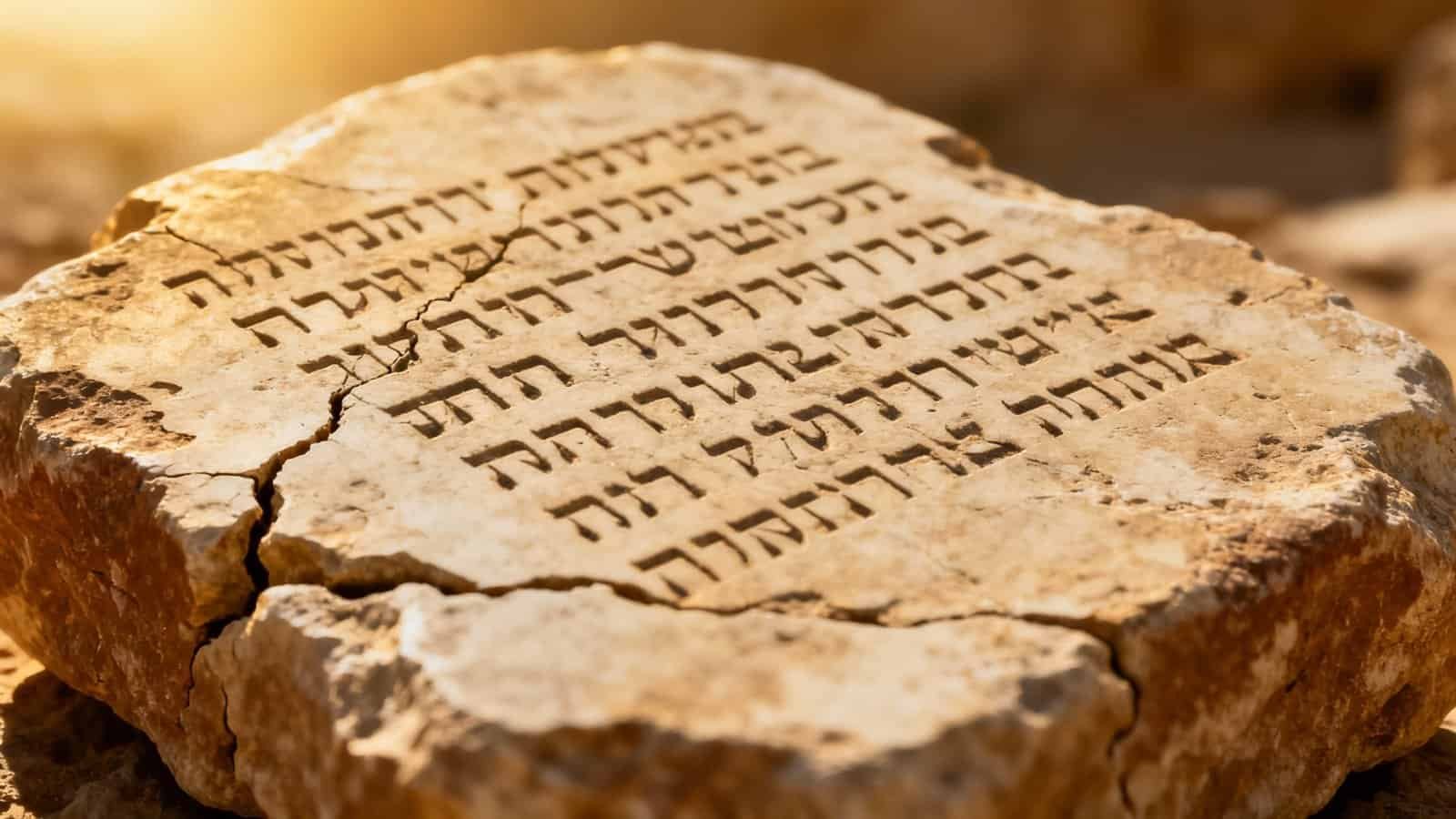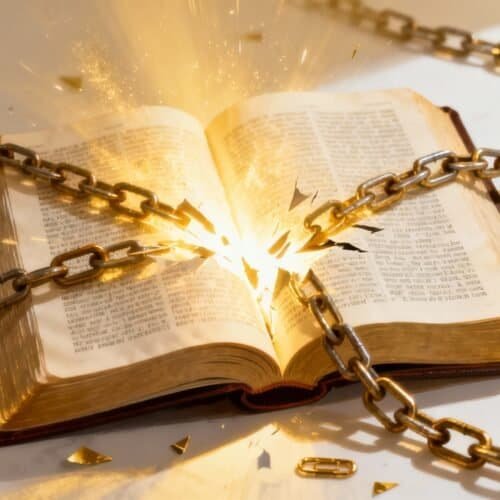
23 Nov 10 Commandments What the Bible Really Says and Why It Matters Today
You’re encountering the עֲשֶׂרֶת הַדְּבָרִים (aseret ha-d’varim)—”ten words” from Sinai that revolutionized ancient law by addressing everyone equally, from slaves to nobles. Unlike Hammurabi’s class-based codes, these apodictic commands (“You shall not”) established universal ethics: רָצַח (ratzach) prohibited murder specifically, not all killing; Sabbath rest extended to servants and animals; property rights existed independent of royal decree. Their dual structure—duties to God, then neighbor—shaped Western jurisprudence and constitutional principles that still govern digital privacy, economic justice, and human dignity debates today.
Table of Contents
Key Takeaways
- The Hebrew text literally means “ten utterances” (aseret ha-d’varim), with two biblical versions in Exodus 20 and Deuteronomy 5 containing slight variations.
- The commandments establish both religious duties to God (1-4) and ethical obligations to neighbors (5-10), forming Western law’s foundation.
- Biblical Hebrew distinguishes murder (ratzach) from killing, while “covet” addresses internal desires, making the Decalogue unique among ancient law codes.
- Unlike class-based ancient Near Eastern laws, the Ten Commandments apply equally to all people regardless of social status.
- The Sabbath command instituted universal rest for workers, servants, and animals—revolutionary labor protection that influences modern workplace rights.
The Historical Context: When, Where, and Why These Laws Were Given

Learn the 10 commandments from the Bible with this colorful educational poster highlighting key verses from Exodus. Perfect for Sunday school or religious study sessions.
When you examine the Hebrew text of Exodus 19-20, you’re encountering a pivotal moment in ancient Near Eastern history—the establishment of a covenant between YHWH and the newly liberated Israelites at Mount Sinai around the 13th century BCE.
The Sinai covenant marks ancient Israel’s revolutionary transformation of Near Eastern law into divine apodictic commands.
Archaeological dating places this within Egypt’s Nineteenth Dynasty, when semi-nomadic groups traversed the Sinai Peninsula.
You’ll notice the Decalogue‘s structure mirrors Hittite suzerainty treaties, reflecting established legal anthropology patterns of the Late Bronze Age.
The religious context reveals these weren’t merely ethical guidelines—they’re covenant stipulations binding a vassal people to their divine sovereign.
When you study the Sinai traditions, you’re observing how ancient Israel transformed existing Near Eastern law codes into something revolutionary: apodictic commands (“You shall not”) rather than casuistic formulations (“If someone does X, then Y”).
This shift represents Israel’s unique contribution to jurisprudence, where divine will supersedes situational ethics, establishing absolute moral boundaries that transcended their original desert sanctuary setting.
Breaking Down Each Commandment: Original Hebrew Text and Modern Translation
As you delve into the original Hebrew text of the Decalogue, you’ll discover that what English translations render as “Ten Commandments” actually appears as עֲשֶׂרֶת הַדְּבָרִים (aseret ha-d’varim)—literally “ten words” or “ten utterances”—revealing their nature as divine proclamations rather than mere legal prescriptions.
You’ll find significant translation nuance in the opening statement. Where English reads “You shall have no other gods before me,” the Hebrew phrasing אֱלֹהִים אֲחֵרִים (elohim acherim) suggests “other gods in my presence.”
Similarly, the prohibition against killing uses רָצַח (ratzach), specifically denoting murder rather than all killing—a distinction lost in some translations.
The Sabbath commandment’s Hebrew זָכוֹר (zachor) means “remember,” while Deuteronomy’s parallel uses שָׁמוֹר (shamor), “guard.” You’re seeing complementary aspects of observance.
The final commandment’s לֹא תַחְמֹד (lo tachmod) encompasses both “covet” and “desire,” reflecting internal disposition rather than external action—a revolutionary concept in ancient law codes.
The Two Different Biblical Versions and What Changed Between Them
Though you’ll encounter the Ten Commandments in both Exodus 20:2-17 and Deuteronomy 5:6-21, these versions aren’t identical—they reflect distinct historical contexts separated by Israel’s forty-year wilderness journey. The Exodus account represents the original Sinai covenant context, while Deuteronomy offers Moses’s retelling before entering the Promised Land.
You’ll notice key textual variants between them. The Sabbath commandment shows the most significant difference: Exodus grounds it in creation (שָׁבַת, shavat—”He rested”), while Deuteronomy emphasizes liberation from Egyptian slavery. Deuteronomy adds “as the LORD your God commanded you” to honoring parents and includes your neighbor’s “field” in the coveting prohibition.
These changes aren’t errors—they’re deliberate adaptations. Moses reshapes the commandments for a generation born in the wilderness, emphasizing social justice and communal responsibility. The variations reveal how divine law adapts to new circumstances while maintaining its core ethical demands, demonstrating the dynamic nature of biblical revelation.
How the Commandments Shaped Western Legal Systems and Constitutional Law
You’ll find the Decalogue’s influence deeply embedded in English common law through medieval Christian jurisprudence, where prohibitions against murder, theft, and perjury formed the backbone of criminal statutes.
The commandments’ dual structure—religious obligations toward God and civil duties toward neighbors—directly shaped the Western concept of separating ecclesiastical and secular authority, ultimately informing constitutional provisions for religious freedom.
This tension between the Torah’s theocratic origins and Enlightenment liberalism created the paradox you see in modern democracies: legal systems rooted in biblical morality that simultaneously guarantee freedom from religious coercion.
Common Law Foundations
Medieval jurists didn’t merely adopt these commandments; they’ve woven them into jury rights and procedural safeguards.
The Hebrew concept of multiple witnesses (עֵדִים, edim) established evidentiary standards you’ll recognize in modern courtrooms.
England’s legal tradition transformed Mosaic law into practical jurisprudence, creating precedents that you’ll find governing everything from contract enforcement to criminal proceedings.
This synthesis produced a legal framework that’s both divinely inspired and pragmatically adapted.
Constitutional Religious Freedom
When colonial founders drafted constitutional provisions protecting religious liberty, they’re drawing directly from the Torah’s prohibition against forced worship (לֹא יִהְיֶה־לְךָ אֱלֹהִים אֲחֵרִים, “you shall have no other gods”) and its implicit recognition of conscience rights. You’ll find Madison’s Memorial and Remonstrance echoes Deuteronomy’s insistence that faith can’t be coerced. The First Amendment‘s church-state separation reflects rabbinic interpretation of דִּינָא דְּמַלְכוּתָא דִּינָא (“the law of the land is law”), establishing secular accommodation while preserving religious autonomy.
Your constitutional conscience protections stem from biblical precedent—Daniel’s refusal to worship Nebuchadnezzar’s idol established civil disobedience principles. Religious pluralism, though seemingly modern, finds roots in Talmudic requirements that non-Jewish courts respect diverse beliefs. You’re inheriting legal frameworks where biblical commandments transformed into universal rights protecting all faiths.
The Revolutionary Social Ethics Hidden in Ancient Stone Tablets
You’ll find that the Decalogue’s social framework overturned ancient Near Eastern norms by establishing radical equality—unlike Hammurabi’s class-based justice, every person from servant to sovereign faced identical divine commands.
The Hebrew term “lo tignov” (thou shalt not steal) revolutionized property rights by protecting individual ownership against state confiscation, a concept foreign to despotic kingdoms where rulers claimed absolute dominion.
Most striking, the Sabbath mandate extended rest to “your male servant and your female servant” (Exodus 20:10), creating history’s first universal labor protection that transcended social hierarchy.
Equality Before Law
Every ancient Near Eastern law code before the Decalogue explicitly codified different penalties for crimes based on social class—striking a nobleman cost more than striking a commoner in Hammurabi’s Babylon, while Egypt’s legal papyri prescribed harsher punishments for offenses against priests than merchants.
You’ll find the Torah’s radical departure in Exodus 23:3: “nor shall you favor the poor in his lawsuit.” This principle of equal justice appears throughout Deuteronomy, where judges receive the command “lo takir panim”—don’t recognize faces—establishing impartial courts regardless of status.
When you examine the Decalogue’s apodictic formulations, they’re addressed to all Israelites equally. No distinction exists between noble and slave, priest and farmer.
This egalitarian framework revolutionized jurisprudence, introducing a concept that wouldn’t resurface in Western legal thought for millennia.
Property Rights Revolution
Reshut—the Hebrew concept of legitimate dominion—transforms into something unprecedented when the Decalogue declares “lo tignov” (you shan’t steal).
You’re witnessing ancient Israel’s radical departure from surrounding civilizations where kings owned everything. The eighth commandment establishes individual property rights as divinely sanctioned, not merely royal grants.
Consider how this disrupted ancient land tenure systems. While Egypt’s pharaoh controlled all property and Mesopotamian rulers claimed ultimate ownership, Israel’s law recognized permanent family holdings (naḥalah).
You’ll find this revolutionary principle embedded in Levitical jubilee laws, which balanced private ownership with communal ownership obligations. The prohibition against theft doesn’t just protect possessions—it legitimizes having them.
When you can’t steal, you’re acknowledging another’s rightful claim exists independently of state power. This seemingly simple command birthed Western property law’s foundation.
Rest for All
The property rights revolution finds its most radical expression in the fourth commandment‘s mandate of universal sabbath rest. You’re witnessing ancient Israel’s most egalitarian innovation: mandatory community rest extending to slaves, foreigners, and even animals (Exodus 20:10). The Hebrew verb שָׁבַת (shavat) doesn’t merely mean “cease”—it demands complete restoration.
This wasn’t voluntary charity but enforceable law. You’ll find Sabbath advocacy embedded in prophetic literature, where Jeremiah condemns merchants who violate rest protocols (Jer 17:21-22). The commandment subverts Near Eastern power structures where elite classes monopolized leisure while laborers worked continuously. By institutionalizing universal rest, you’re seeing economic justice encoded in ritual practice. This radical equality—where servants rest alongside masters—prefigures modern labor rights movements, proving the sabbath principle remains revolutionary three millennia later.
Modern Applications: Digital Privacy, AI Ethics, and Social Media Morality
As digital technologies reshape human interaction and moral decision-making, the ancient wisdom of the Decalogue offers surprisingly relevant guidance for navigating contemporary ethical challenges. You’ll find the prohibition against bearing false witness (עֵד שָׁקֶר, ‘ed shaqer’) directly applies to spreading misinformation online, while “You shan’t steal” extends to data theft and intellectual property violations.
Consider how digital dignity mirrors the imago Dei principle underlying the commandments—every person’s inherent worth demands protection in virtual spaces. When you engage on social media, the commandment against coveting challenges algorithmic designs that deliberately trigger comparison and envy. Algorithmic justice reflects the biblical mandate for impartial judgment (Deuteronomy 16:19), requiring you to question AI systems that perpetuate bias.
The Sabbath principle now confronts your screen-time habits, calling for deliberate disconnection. Ancient Israel’s covenant community understood that ethical boundaries preserve human flourishing—a truth you’re rediscovering as unregulated technology threatens privacy, authenticity, and genuine relationships.
Common Misunderstandings About What the Commandments Actually Prohibit
While modern technology challenges you to reinterpret ancient ethical principles, centuries of translation and cultural distance have already obscured what the Decalogue originally prohibited. You’ve likely encountered misinterpreted prohibitions that don’t align with the Hebrew text’s actual meaning.
Consider “You shan’t kill” – the Hebrew verb רָצַח (ratzach) specifically denotes murder, not all killing. Ancient Israel’s laws permitted capital punishment and warfare, revealing contextual exemptions the commandment never addressed. Similarly, when you read “You shan’t steal,” you’re encountering a prohibition that originally may have referred to kidnapping – stealing persons – rather than property theft.
The Sabbath commandment doesn’t universally prohibit work but rather מְלָאכָה (melachah) – creative labor that mirrors divine creation. You’ll find the adultery prohibition specifically addressed married women’s sexual conduct in its ancient context, reflecting property-based marriage systems. Understanding these distinctions helps you grasp what the commandments actually demanded versus what tradition has imposed.
The Psychological and Sociological Genius Behind the Order and Structure

When you examine the Decalogue’s architecture, you’re encountering a sophisticated psychological progression that moves from theological abstraction to concrete social regulation. The cognitive sequencing isn’t accidental—it establishes divine authority legitimation before addressing interpersonal ethics. You can’t understand “lo tirtzach” (don’t murder) without first accepting “Anochi YHWH” (I am the LORD).
The structure creates group cohesion through shared boundaries. You’re bound to others who observe the same prohibitions, forming what sociologists call “normative communities.” The Sabbath commandment functions as ritual reinforcement, requiring weekly collective practice that strengthens communal identity.
Notice how the progression moves from God (1-4) to family (5) to community (6-10). You’re guided from abstract monotheism through kinship structures into broader social contracts. This mirrors developmental psychology—children first comprehend parental authority before understanding societal rules. The ancient redactors understood that sustainable ethical systems must align with how humans naturally process moral information.
Comparing Moses’ Tablets to Other Ancient Near Eastern Law Codes
The Decalogue’s psychological architecture finds striking parallels in Mesopotamian legal traditions that predate Moses by centuries. You’ll notice Hammurabi’s Code (1750 BCE) shares the apodictic “thou shalt not” structure, while the Hittite treaties demonstrate identical covenant parallels—divine authority, historical prologue, stipulations, and blessings-curses formula. The vassal treaties of Esarhaddon mirror the Sinai covenant‘s legal formatting precisely.
Yet Moses’ tablets revolutionize ancient jurisprudence. Where Hammurabi addresses property crimes first, the Decalogue prioritizes relationship with YHWH. You won’t find class distinctions in the עֲשֶׂרֶת הַדְּבָרִים (Aseret ha-Dibrot)—they apply universally. The Code of Ur-Nammu prescribes monetary penalties; Moses demands moral transformation. While Mesopotamian codes regulate external behavior through graduated punishments, you’re confronted with internal prohibitions against coveting. The tablets’ brevity—merely 172 Hebrew words—contrasts sharply with Hammurabi’s 282 laws. This compression achieves what thousands of cuneiform tablets couldn’t: portable, memorable ethics that transcend cultural boundaries.
Why These Bronze Age Principles Still Resonate in Contemporary Moral Debates
Despite their Bronze Age origins, you’ll find the Decalogue‘s moral imperatives embedded in virtually every contemporary ethical framework—from international human rights declarations to Silicon Valley’s AI ethics boards. You’re witnessing what anthropologists call ethical universals—principles that transcend their original ritual symbolism to address perennial human concerns about justice, property, and social cohesion.
When you examine the Hebrew term צֶדֶק (tzedek, “righteousness”), you’ll discover it encompasses both legal justice and moral rectitude—a duality that explains the commandments‘ enduring moral resonance. They’ve survived through cultural adaptation, with societies reinterpreting prohibitions against theft, murder, and false witness to address contemporary challenges like intellectual property and digital privacy.
You can’t dismiss these principles as mere Bronze Age artifacts when they’re actively shaping debates about bioethics, economic inequality, and artificial intelligence. Their persistence reveals something fundamental: they address tensions between individual desires and communal flourishing that you’ll encounter regardless of technological advancement.
Frequently Asked Questions
Are Christians Required to Follow All Ten Commandments Today?
You’re not bound to follow all Ten Commandments as originally given in the Hebrew Torah. Under the New Covenant, you’ll find the Moral Law principles remain binding—don’t murder, steal, or commit adultery—but Sabbath Observance shifts from Saturday to Sunday worship in most traditions.
The Cultural Context of ancient Israel’s ceremonial laws doesn’t apply directly to you. Christ fulfilled the law (Matthew 5:17), transforming how you’re called to observe God’s commandments today.
What Happened to the Original Stone Tablets Moses Received?
The original stone tablets Moses received were broken when he witnessed Israel’s golden calf idolatry (Exodus 32:19). God instructed him to carve replacement tablets, which were placed in the Ark of the Covenant.
You’ll find various ark speculation theories about their fate—some scholars suggest they disappeared during the Babylonian exile (586 BCE). The Hebrew term “luchot ha’brit” (covenant tablets) emphasizes their sacred nature.
These lost tablets remain archaeology’s greatest mystery.
Do Jews, Christians, and Muslims Interpret the Commandments Differently?
Yes, you’ll find significant differences across traditions. Jewish interpretations emphasize halakhic applications through Talmudic commentary, viewing the Decalogue within 613 mitzvot.
Christians typically follow Augustine’s numbering, emphasizing spiritual fulfillment through Christ’s teachings.
Muslim perspectives acknowledge the tablets (alwāḥ) given to Musa, but integrate commandments within Quranic ethics. You’re seeing divergent theological frameworks: Jews stress covenant law, Christians focus on grace, while Muslims emphasize tawhid’s primacy over ritual prescriptions.
Which Commandment Do People Break Most Often Without Realizing It?
You’re likely breaking the ninth commandment against false witness through unintentional dishonesty more than you realize. The Hebrew term “ed sheker” encompasses not just courtroom perjury but everyday deceptions—exaggerations, white lies, selective truths.
Additionally, you violate the Sabbath commandment through misplaced priorities, treating rest as productivity’s enemy rather than creation’s rhythm. Ancient Israelites understood these commandments shaped daily ethics, not just dramatic moral failures you’d easily recognize.
Can Someone Be Forgiven for Breaking the Commandments?
Yes, you can receive forgiveness through the biblical framework of teshuvah (Hebrew: “return”).
When you’ve broken commandments, grace received through sincere repentance initiates a restoration process documented throughout Scripture.
Ancient confession practices, from Yom Kippur rituals to David’s psalms, demonstrate God’s forgiveness culture.
The Hebrew term selichah encompasses divine pardon, while the New Testament extends this through Christ’s atonement, ensuring you’re never beyond redemption’s reach.
Conclusion
You’ve traced the Decalogue from Sinai’s theophany through millennia of interpretation, encountering both the Exodus (מִשְׁפָּטִים) and Deuteronomic recensions. You’ve seen how these apodictic laws transcended Hammurabi’s casuistic codes, revolutionizing ancient jurisprudence. Whether you’re wrestling with sabbath observance or coveting’s psychological dimensions, you can’t escape their enduring relevance. These aren’t mere Bronze Age artifacts—they’re living principles that continue shaping ethical discourse, legal frameworks, and humanity’s ongoing struggle to balance divine imperatives with social justice.










No Comments